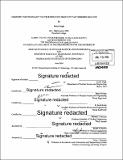Ssessment methodology for proliferation resistant fast breeder reactor
Author(s)
Singh, Mohit, S.M. Massachusetts Institute of Technology
DownloadFull printable version (14.07Mb)
Alternative title
Assessment methodology for proliferation resistant fast breeder reactor
Other Contributors
Massachusetts Institute of Technology. Technology and Policy Program.
Advisor
Benoit Forget and R. Scott Kemp.
Terms of use
Metadata
Show full item recordAbstract
Due to perceived proliferation risks, current US fast reactor designs have avoided the use of uranium blankets. While reducing the amount of plutonium produced, this omission also restrains the reactor design space and has several disadvantages over blanketed cores. This study investigated many blanket options that would satisfy the proliferation concern while minimizing negative fuel cycle impact. To do so, a multi-variable metric was developed that combines 6 attributes: proliferation resistance, fuel fabrication, radiotoxicity, breeding gain, reactivity penalty and transportation. The final version of the metric consisted of using a yes or no decision on the proliferation criteria proposed by Bathke (for technologically advanced nations). The remaining 5 attributes are scaled between 0 and 1 with assigned weights for each. For our analysis, a 2400MWth sodium cooled core was considered. One row of blanket was added radially. Metal fuel composed of depleted uranium, zirconium and Np/Pu from light water reactor used fuel was used for the driver. It was determined that to meet the prescribed proliferation resistance criteria, a minimum of 4% MA (by volume) was needed in the blanket assemblies. However, increasing the amount of MA past 4% became detrimental to the combination of the other 5 attributes, mainly impacting the radiotoxicity, fuel fabrication and transportation. The addition of moderation by itself did not provide any means of dissipating proliferation issues. In the cases studied, it was determined that ZrH1.6 and BeO were the most promising moderating materials. They both provided some reduction in required MA concentration but at the expense of the radiotoxicity of the end product. Using our defined metric, it was determined that moderation provided no immediate benefit. It should also be noted that the homogeneous or heterogeneous addition of moderators has minimal impact on such scoping studies. Separation of the Cm/Bk/Cf vector from the Am was also studied. The blankets were composed of Am while the remaining Cm/Bk/Cf was left to decay in storage. The metric was then applied to the combined streams for all attributes except proliferation. The separated case performed worst in all cases examined. Also, as expected, varying the uranium composition vector from natural (NU), depleted (DU) and recycled (RU) had very little impact on our metric, thus the choice of uranium vector would be mostly left to cost and initial fabrication considerations. It should however be noted that the k-infinity at beginning-of-life was obviously higher for the recycled and natural cases. Looking at the reactivity over the first cycle indicates that NU provides an additional -40pcm over DU while RU provides -60pcm, which could provide 30 and 45 extra days of operation, respectively, or a reduction in driver core enrichment for a given cycle length.
Description
Thesis: S.M., Massachusetts Institute of Technology, Department of Nuclear Science and Engineering, 2014. Thesis: S.M. in Technology and Policy, Massachusetts Institute of Technology, Engineering Systems Division, Technology and Policy Program, 2014. Cataloged from PDF version of thesis. Includes bibliographical references (pages 70-72).
Date issued
2014Department
Massachusetts Institute of Technology. Department of Nuclear Science and Engineering; Massachusetts Institute of Technology. Engineering Systems Division; Technology and Policy ProgramPublisher
Massachusetts Institute of Technology
Keywords
Nuclear Science and Engineering., Engineering Systems Division., Technology and Policy Program.